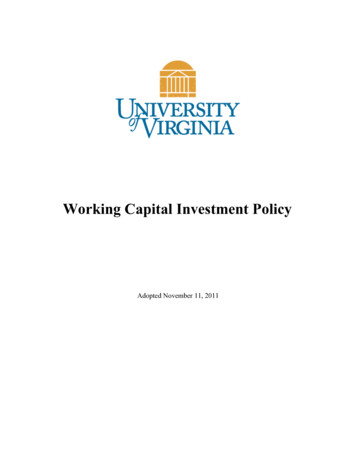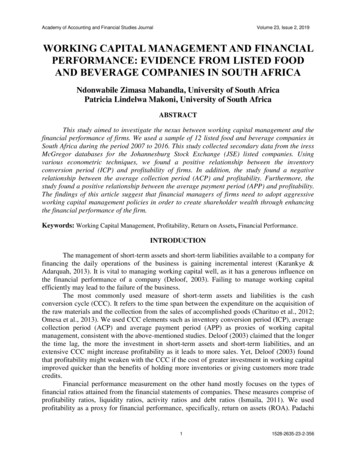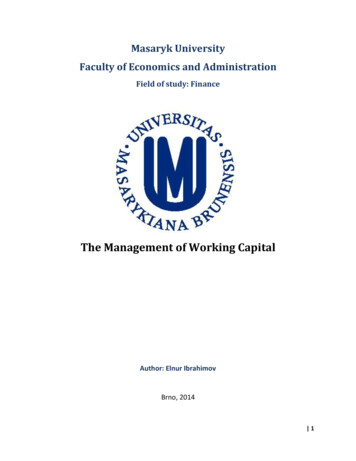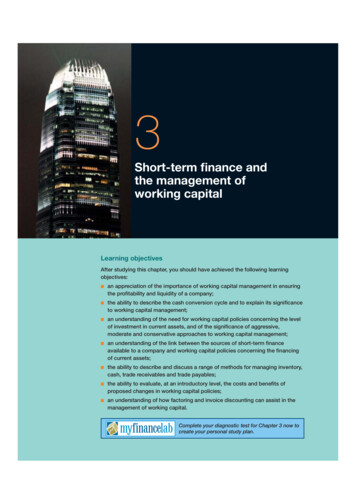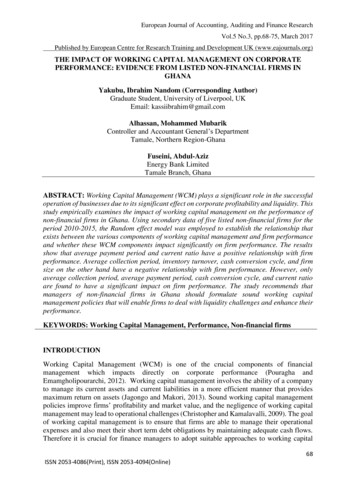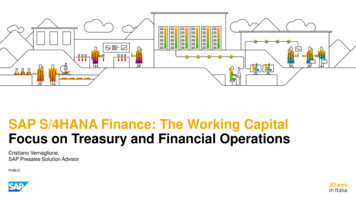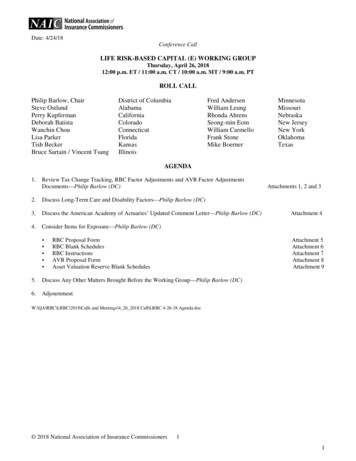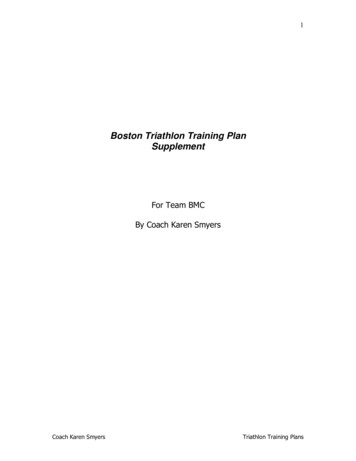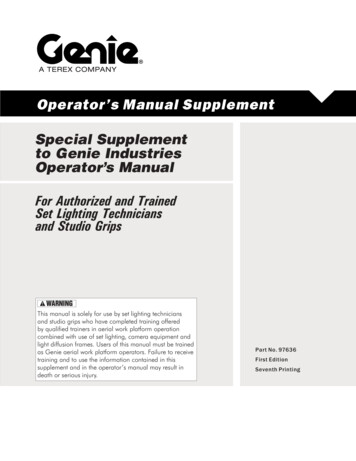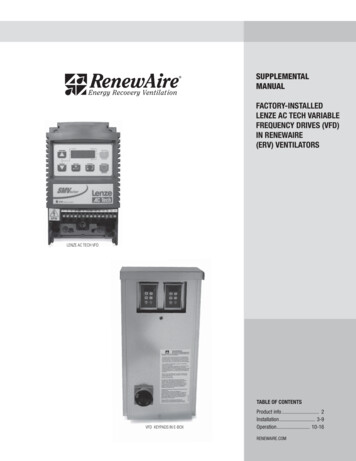
Transcription
SIMULATION SUPPLEMENTWorking Capital Simulation: Managing GrowthProblem Set QuestionsProblem 1Estimate the net working capital and cash conversion cycle in 2012 for McDonald’s Corporation based onthe data provided in the following chart:Income Statement for the PeriodEndingRevenue12 Months:December 31, 201112 Months:December 31, 201227,006.027,567.0Cost of Goods Sold(16,319.4)(16,750.7)Gross Profit10,686.610,816.3(2,393.7)(2,455.2)Operating Income8,292.98,361.1Net Interest 9.12,614.25,503.15,464.8Selling: General and AdministrativeExpensesOther Net Operating Income(Expenses)EBT, Including Unusual ItemsIncome Tax ExpenseNet Income to CompanyBalance Sheet as ofDecember 31, 2011December 31, 2012ASSETSTotal Cash and ST Investments2,345.12,340.3Accounts Receivable1,334.71,375.3
Working Capital Simulation: Problem SetInventory116.8121.7Prepaid Expenses513.7880.592.7204.3Total Current Assets4,403.04,922.1Net Property, Plant, andEquipment22,834.524,677.2Long-Term .3603.61,019.9961.032,989.935,386.5Accounts Payable961.31,141.9Accrued Expenses1,896.61,952.2Current Portion of Long-Term Debt366.6—Other Current Liabilities (IncludingIncome Taxes 942.73,057.3Total Liabilities18,599.720,092.9Total Equity14,390.215,293.6Total Liabilities and Equity32,989.935,386.5Other (Including Current DeferredTax Assets)Deferred Tax Assets, Long-TermOther Long-Term AssetsTotal AssetsLIABILITIESTotal Current LiabilitiesLong-Term DebtOther Noncurrent Liabilities (InDeferred Taxes)Source: Capital IQ2
Working Capital Simulation: Problem SetProblem 2Captivate Remodeling is a small, owner-managed construction company. The owner, Bob, typically workson a single residential remodeling project at a time. The business is very simple because Bob does not carryany inventory. The project is completed in four months, on average; thus, Bob can take on three projectseach year. The total cost that he bills to his clients averages 400,000, so he books revenues of 1,200,000per year. After accepting a project, Bob collects the payments from his client in two installments. He collectsthe first installment of 200,000 at the end of the second month, and the balance of 200,000 at the end ofthe project (i.e., at the end of four months). Bob’s expenses are largely payments to his subcontractors (e.g.,plumbers, electricians, and so on). Bob pays all his subcontractors every week once they start on the job(for simplicity, assume that he pays his subcontractors four times a month). His margin on a project is 10%,so his payment for expenses every week is, on average, 22,500. Bob is constantly being asked to take onmore projects due to his excellent reputation. He also has an excellent network of subcontractors and couldeasily take on more projects. He is thinking about taking on six projects each year and, instead of workingon a single project at a time, working on two overlapping projects simultaneously.1.2.How much capital will Bob need to double his business?If Bob has only half the capital needed and cannot obtain any additional loans, what possibleavenues exist for him to achieve this growth?3
Working Capital Simulation: Problem SetProblem 3Natasha Brown runs a specialist food store in Portland, Oregon. The store specializes in hard-to-find foodand condiments such as Milifiore Honey from Tuscany, Blue Stilton Cheese from England, and so on. Thestore keeps an inventory that, valued at cost, is approximately 1.2 million. The store generates averagesales of 2 million per year, with an operating margin of 8% (after tax). News about her excellent foods hasspread, and Natasha is considering opening an online retail option for the limited selection of the mostpopular products. Many of these products are sourced from around the world and involve long lead times.Natasha would need to order a number of these items in advance to make sure she has adequate supplies.She estimates that the online channel can generate an additional 400,000 in sales. She would have to spendabout 150,000 upfront to build a robust online store website. (She estimates that the cost of capital for asmall business like hers is about 15%.) Natasha also expects the operating margins from the business to bethe same as her existing business. Assuming that additional sales from the online channel will be sustainedfor the foreseeable future (in perpetuity), is this project worth undertaking?4
Working Capital Simulation: Problem SetProblem 4Gluten-Free Baked Goods has created a niche for itself by creating and marketing a line of gluten-free cakesand desserts. The company has annual sales of 5 million. It has grown slowly but steadily; the ownershave avoided all debt and have relied on internal funds to sustain growth. The firm has no debt and hasgenerated an after-tax operating income of 400,000. The firm purchased its supplies of sugar, gluten-freeflour, specialty yeasts, and other raw ingredients from a number of suppliers. Even though the ownerswere offered 2/10 Net/30 terms by their suppliers, they paid cash on delivery. One of the owners statedthe rationale for this as follows: “We hate to owe anybody anything. Once we have the supplies and if welike the quality, we like to pay when we get the delivery. After all, our customers pay us right when theybuy our product!” The cost of goods sold were 80% of the sales. The owners were recently approached byanother specialty food manufacturer who wanted to buy the business for 4 million. The interested firmexplained that it had simply taken the perpetuity value of the most recent after-tax operating income usinga cost of capital of 12% to arrive at the value. (The analysis included a long-term growth potential of 2%per year.) The estimated value was 400,000/(0.12 0.02). The owners generally agreed with all theassumptions but were still a bit unsure about the value. They felt that the offer failed to reflect theconservative policies that they have been following. Do you agree with the owners? What would be yourestimate of the extra value that should be offered for Gluten-Free Baked Goods?5
13.05.2014 · SIMULATION SUPPLEMENT Working Capital Simulation: Managing Growth Problem Set Questions Problem 1 Estimate the net working capital and cash conversion cycle in 2012 for McDonald’s Corporation based on the data provided in the following chart: Income Statement for the Period Ending 12 Months: December 31, 2011 12 Months: December 31, 2012

